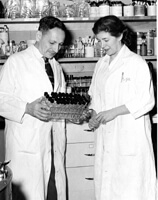Research History (2 of 3)
In 1946, a Cardiopulmonary Physiology Laboratory was established, the first in the Rocky Mountain area and the first in the country in a chest hospital. The laboratory was primarily devoted to clinical research, and the heart and lung functions of patients were studied with detailed thoroughness. The lab received many research grants and it was one of the first to receive grant money from health insurance companies, and later from the federal government, for equipment and staff to do heart catheterizations in the 1950s.
Expanding Basic Research
 In 1959, a $1.25 million basic research laboratory building was completed, and it was considered to be the largest and most modern laboratory in the world devoted entirely to chest research. This five-story facility was used for biological research related to TB, heart disease, asthma and several other lung diseases, and it extended the hospital’s lab considerably.
In 1959, a $1.25 million basic research laboratory building was completed, and it was considered to be the largest and most modern laboratory in the world devoted entirely to chest research. This five-story facility was used for biological research related to TB, heart disease, asthma and several other lung diseases, and it extended the hospital’s lab considerably.
Over time, the basic science department centered increasingly on fundamental science: the exploration of biological mechanisms in order to enhance an understanding of nature with the hope of ultimate, rather than immediate, benefits.
By the 1970s, the National Jewish basic science department ranked with the best departments of biology in the country. It had nine independent investigators concerned with what makes living organisms tick. Some of the research related to the diagnosis and treatment of disease, but most of it did not. Here, as was true elsewhere around the institution, research was intertwined with the training of the next generation of researchers through a post-doctoral training program.
Improving Asthma Treatment
By the early 1970s, National Jewish was becoming an exciting place for asthma research. Because asthma patients were often non-responsive to treatment, physicians brought to their labs tough research questions directly related to their patients’ concerns. One notable goal of researchers was to try to find safer, more effective ways to control asthma.
During this decade, researchers made significant contributions to the use of theophylline. They identified ways to individualize asthma treatment, examined the most appropriate uses of the medication and determined how theophylline could be used best in combination with other asthma drugs. These and many more studies at National Jewish laid some groundwork for current-day asthma treatment.
Merger With National Asthma Center
In 1978, the National Asthma Center, previously called the Children's Asthma Research Institute and Hospital (CARIH, pronounced Car-ee), merged with National Jewish Hospital to create the world's largest inpatient treatment facility for pediatric and adult asthma patients. Researchers at CARIH had made many notable discoveries, including the discovery of Immunoglobulin E (IgE), called the “allergy antibody.” The discovery at last established beyond a doubt that there is a physical basis for asthma.
NEXT: Research in the 1990s and Beyond
Page 1, 2, 3
